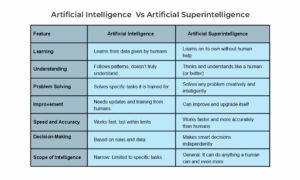Artificial intelligence (AI) has become an integral part of our day-to-day lives. It helps doctors diagnose diseases, drives voice assistants like Siri and Alexa, and even helps banks in detecting fraud. But all of this is still narrow AI. It only does specific tasks for which it is trained.
Now imagine a future where AI doesn’t just follow instructions but thinks, learns, and gets better by itself. That is where artificial superintelligence (ASI) steps in.
What Makes ASI Different?
Current AI systems are like smart tools. They can do amazing things, but only within limits set by humans. ASI, on the other hand, would be smarter than the smartest human in every possible way. Here’s how:
- Self-learning: ASI wouldn’t need constant updates or training from humans. It could teach itself new things.
- Advanced Reasoning: It would be capable of solving complex problems, making decisions, and even generating innovative solutions.
- Self-improvements: ASI would be able to improve its own hardware and software in order to become even more intelligent without assistance from humans.
Why Does Artificial Superintelligence Matter?
If ASI becomes a reality, it would transform science and medicine, education and space travel, and much more. But it also creates big questions:
- Will humans still be in control?
- How do we make sure ASI is safe and ethical?
- What happens if ASI’s goals don’t match ours?
Difference Between Artificial Superintelligence and Artificial Intelligence
Modern AI is intelligent, but it can only do what it is programmed to do. It operates with rules and according to the data that we give to it. For instance, programs such as ChatGPT may write like a human, but they do not actually know what they are writing. They only know how to react based on patterns.
Artificial Superintelligence (ASI) would be far smarter than any human. It would not merely obey instructions; it would reason for itself, learn new concepts, and get around obstacles in novel and unexpected ways.
Whereas the current AI relies on humans for improvement, ASI may improve itself, make choices, and even generate new concepts all by itself.
Artificial superintelligence, however, would have general intelligence; it means they have the ability to do any intellectual task a human is able to, but more quickly, more precisely, and without exhaustion. It would not simply obey instructions; it would think, learn, and develop on its own.
The Potential Future Effect of ASI
Revolutionizing Science and Medicine
One of the most thrilling possibilities of ASI is its ability to adapt to scientific advances. Consider an AI that can cure illnesses by decoding genes in a matter of seconds, create new materials for space travel, or resolve climate change by restructuring energy usage. Artificial superintelligence has the ability to drive human history into a level of unprecedented innovation.
Redesigning the Workplace
Whereas AI currently performs daily tasks, ASI might replace other sophisticated jobs. Law analysis engineering even creative professionals such as music and art. This poses fears over job loss but also creates opportunities for new careers in managing ethical regulations.
Ethical and Existential Questions
With great power comes great responsibility. Who is in charge if ASI outstrips human intelligence? How do we guarantee it is in line with human values? These are ethical issues of utmost importance. If artificial superintelligence is not properly constrained, it may make decisions that are in conflict with human flourishing.
Economic and Geopolitical Shifts
Nations leading in ASI development could gain massive economic and military advantages. This could widen global inequalities, creating a divide between countries with superintelligent systems and those without. International cooperation will be essential to prevent misuse.
Challenges in Developing ASI
Creating artificial superintelligence isn’t just a technical challenge. It’s a philosophical one. Some key hurdles include:
- Alignment Problem: Ensuring ASI’s goals match human values.
- Control Mechanisms: Preventing unintended harmful actions.
- Unpredictability: ASI can come up with solutions outside human understanding.
Experts like Elon Musk and Stephen Hawking have warned that if we are not cautious, AI can get out of control. This is why organizations such as OpenAI and DeepMind are busy formulating rules to ensure that AI is invented in a safe and responsible manner.
What’s Next for ASI?
The future of ASI is thrilling but also unclear. If used responsibly, ASI will be able to solve the biggest issues of humanity, i.e., disease, poverty, and climate change. But if mishandled, it can turn into a major threat to humanity.
What Can We Do?
Scientists, leaders, and experts in ethics must collaborate to ensure ASI benefits all, and not just a few. Teamwork and planning are essential in making ASI safe and beneficial to everyone.
Wrapping up!
Artificial superintelligence is no longer science fiction. It is a very real threat or opportunity over the next few decades. The issue is not that we can’t create ASI, but how we do it responsibly. By keeping ethics, safety, and international cooperation our top priority, we can harness their potential to create a better future.
To learn more, visit HiTechNectar!
FAQs
Q1. What is artificial intelligence?
Answer: It’s a kind of AI that would be more intelligent than humans in all respects, i.e., thinking, learning, and problem-solving on its own.
Q2. What is AGI vs ASI
Answer: Artificial general intelligence (AGI) is capable of doing anything a human can do. ASI extends beyond that; it is even smarter and quicker than humans.
Q3. Will ASI have feelings?
Answer: Not in the same way as humans. ASI may comprehend emotions, but it won’t experience them in the same way people do.
Q4. Who invented artificial intelligence?
Answer: ASI has not been developed yet. Numerous researchers and organizations are moving towards it, but it’s in the future.
Recommended For You:
Is Artificial Intelligence all Set to Disrupt Digital Marketing?
Artificial Intelligence Revolution: The Guide to Superintelligence



